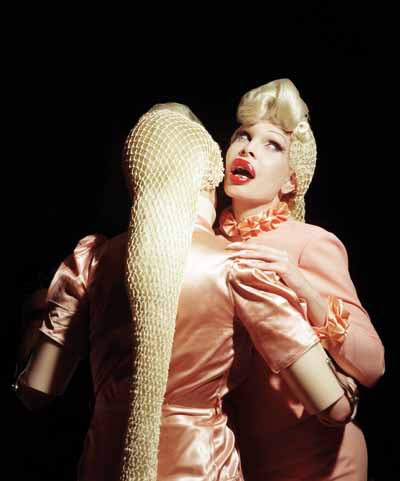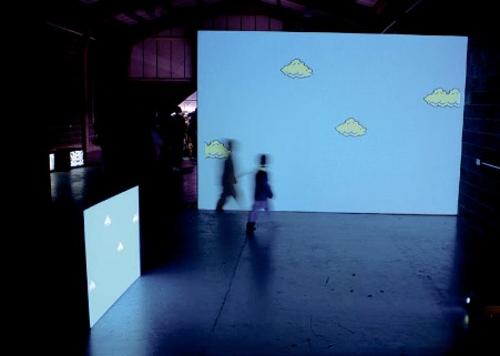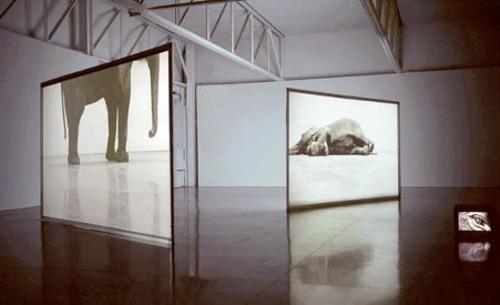
One of my favourite pastimes as a teenager was decorating my ring-binder folder with pictures of famous people. Kneeling at the altar of celebrity, I brandished my scissors like rosary beads and poured over countless images of the latest 'it' girls and boys. Once arranged into a meticulous collage, the folder would be sheathed in clear contact and worshipped (at best) for a full school term, after which the process would be painstakingly repeated to replace the faces of those fallen out of favour.
It was this ritualistic obsession I was reminded of when stepping into New Deities: art and the cult of celebrity as the show includes eight contemporary artists who seek to explore the allure of celebrity and question its place in contemporary society.
Wrapped around the walls of the converted church (what better place to dissect the idiosyncrasies of hero worship), the range of work encompasses painting, photography, video and sculpture. Emanating from John Vella's giant nesting box sarcastically titled Ricky Swallows (Sometimes it's as if we all have Parkinson's disease), a sharp jab at the artist's ascension to considerable fame, is a soothing, tinkling lullaby. Like an accompanying soundtrack, the music gives the exhibition a dreamy yet slightly sinister edge. Things may not be what they seem.
In a collection of production stills from her video performance Lineage of the Divine, Monica Tichacek captures idealised elements of feminine beauty and twists them into a nightmarish vision. Featuring the artist as a Rapunzel-like figure tethered by a length of lustrous blonde hair to American plastic surgery queen Amanda Lepore, Tichacek's images taunt the viewer with menacing repercussions. While Tichacek is overtly pretty in pink, Lepore's physical exaggeration of feminine beauty borders on grotesque. With lips like rubber tubing, heaving breasts and claw-like nails, Lepore embodies the persona of a lurid dominatrix orchestrating our struggle for perfection and desire for endless beauty.
Aspects of performance are also evident in Tiffany Winterbottom's Girls night in photoshoot series. Wrangling her friends into dressing up in frilly lingerie and posing for the camera, Winterbottom has produced loosely staged photographs dripping in soft porn. Often featuring domestic environments in the background, Winterbottom's visual comments on the cult of self-made celebrity exude the essence of a Tupperware party gone wild.
Using the glammed-up snaps of celebrities found in glossy magazines as inspiration, Paul Wrigley's imposing airbrushed portraits of well-known musicians and movie stars loom in front of the viewer like monoliths of fame and fortune. The matte glow created by Wrigley's masterful use of the airbrush lends the portraits an appealing softness, literally blurring the lines between fiction and reality. P. Diddy smiles dreamily into the distance while inverted black and white paintings of Paris Hilton and Lindsay Lohan sear into the memory like soft-boiled X-rays.
A small slice of 80s film Top Gun forms the crux of Grant Stevens' addictively witty video Danger Zone. Subtly editing a romantic exchange between Kelly McGillis and Tom Cruise to only include bemused facial expressions and the nervous breath taken before speaking, Stevens traps the viewer in an endless loop of anticipation that is simultaneously charming in its innocence and infuriatingly funny.
Touching on the almost religious fervour with which the media and its consumers prey on every aspect of celebrity, from the mundane to the outrageous, Emily Hunt and Raquel Welch create panoramic pantomimes filled with cut-out images of celebrities ranging from hot to has-beens. Adorned with fuzzy felt, fake jewels and glitter, I'm a celebrity, get me outta here! offers a unique insight into the fabricated glitz and hyped drama of celebrity personalities and their associated lifestyles.
Succinct and tightly pulled together, New Deities is a thought-provoking exhibition that dismembers the heart of narcissism and exposes the fruits and follies of fame. Like the watery paintings of Jonathan Nichols suggest, the boundaries of celebrity are becoming washed-out and unclear. Given the immense popularity of websites like MySpace and YouTube, as long as a camera and internet connection are readily available, anyone can be an instant star. Rather than a mark of exceptional talent, modern celebrity seems to be nothing more than a swift fix of trashy eye candy at the supermarket checkout, easy to discard and quickly forgotten.












